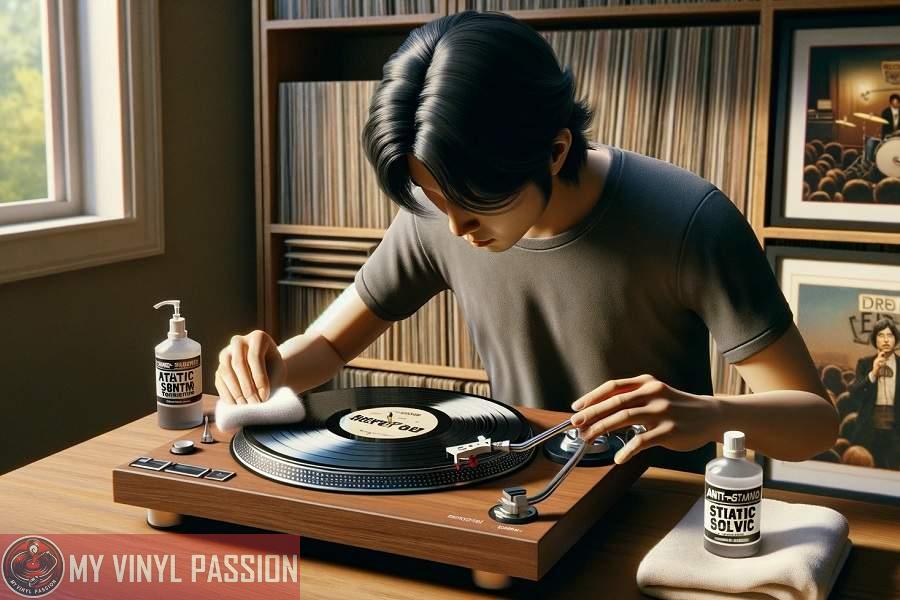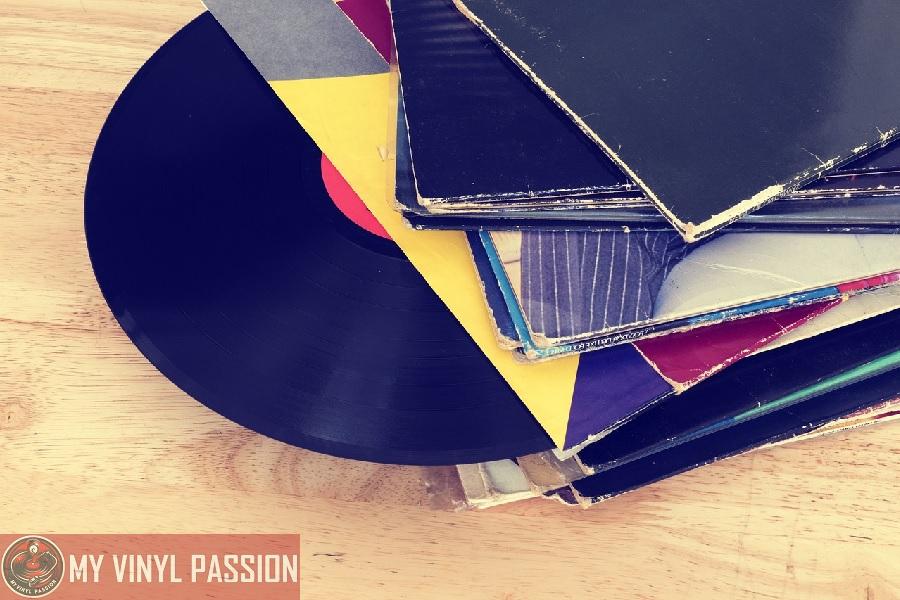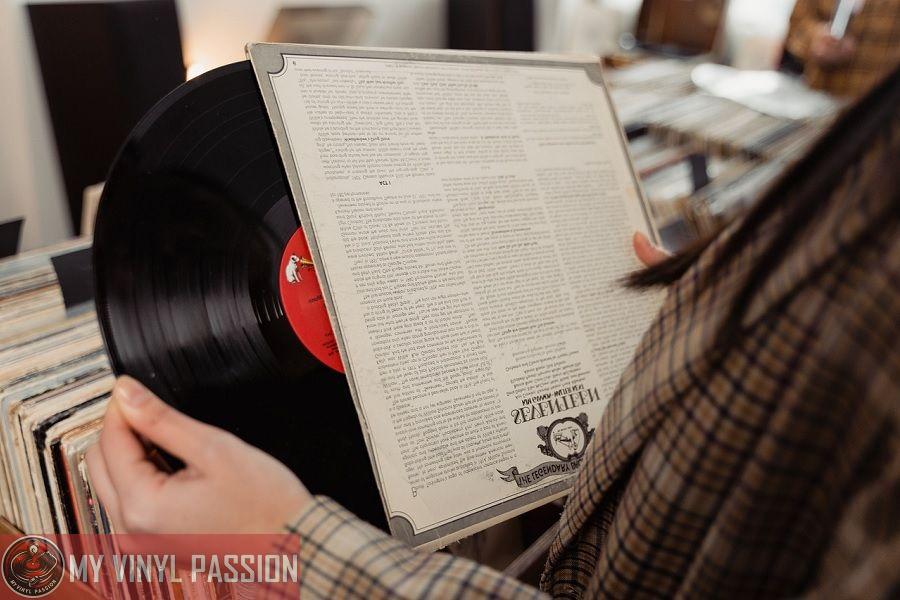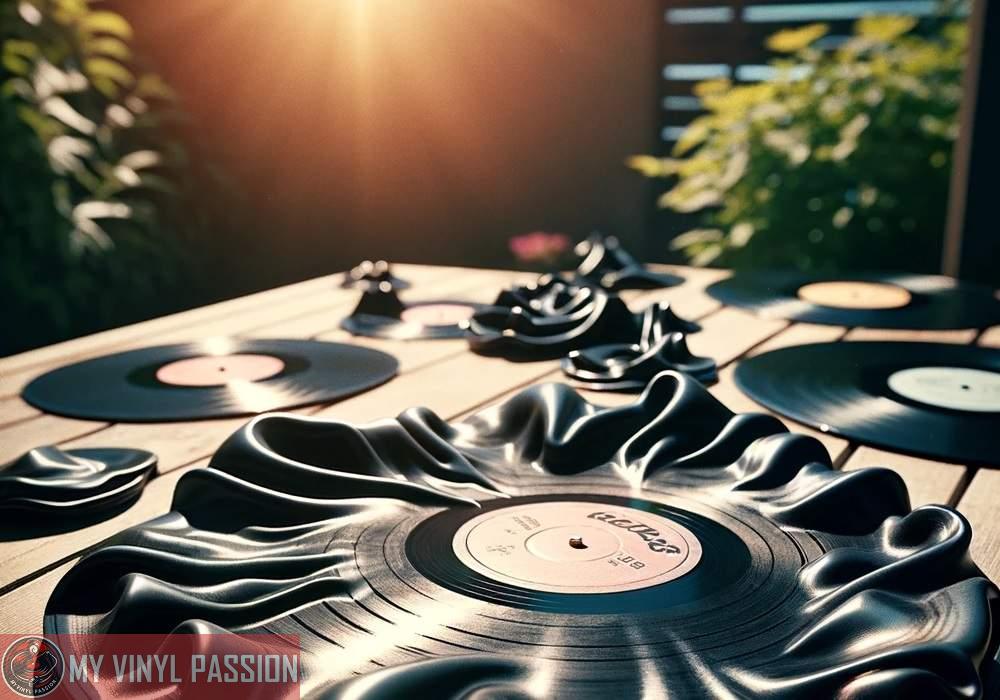One persistent problem for vinyl records enthusiasts is static electricity, which can cause a range of issues from attracting dust to creating unwanted noise in playback.
Static on vinyl records isn’t just an inconvenience; it can degrade the listening experience and potentially damage the delicate grooves of the record.
To address this problem, we need to understand the causes and then implement practical solutions. Handy and effective methods to dissipate static include using anti-static devices, cleaning solutions made specifically for vinyl, and ensuring the environment where the records are kept and played is conducive to reducing static build-up.
A combination of these techniques not only enhances the sound quality but also helps preserve our cherished collections.
In Summary
Static electricity is a common issue for vinyl records, attracting dust and creating unwanted noise, potentially damaging the record’s delicate grooves.
To prevent static and preserve sound quality, it’s crucial to use anti-static devices and vinyl-specific cleaning solutions, and to maintain a record-friendly environment.
Careful handling of vinyl records, including using anti-static measures in regular care routines, is essential to reduce static accumulation and improve record longevity.
Careful handling and maintenance of vinyl records are essential to avoid the accumulation of static electricity.
When removing static, a gentle approach is key to preventing scratches or other damage.
By incorporating anti-static measures into our regular record care routine, we can significantly improve the longevity and performance of our vinyl records, ensuring that the rich, full analog sound remains uncompromised.
Understanding Static Electricity and Vinyl Records
When we discuss static electricity in relation to vinyl records, it’s essential to know that static electricity is the result of an imbalance between negative and positive charges in objects. For vinyl records, these imbalances can cause several issues, primarily attracting dust and affecting playback quality.
How Static Builds Up:
- Friction: As vinyl records spin on the turntable, friction can generate static electricity.
- Environmental Factors: Dry air can exacerbate static buildup, which is why static is often more noticeable in winter or in air-conditioned rooms.
Why It’s an Issue:
- Dust Attraction: Static charges make records attract dust, which not only degrades the sound quality but can also scratch the record’s surface.
- Audible Noise: Static can directly affect playback, adding unwanted noise to the audio.
How We Identify Static Buildup:
- You’ll often feel a zap when touching the record.
- Dust visibly clings to the record despite cleanings.
- A snapping or crackling sound emanates from the record while it plays.
We aim to effectively remove static from the record’s surface, which requires both understanding its origins and taking preventive steps. By tackling the static issue, we ensure a pristine vinyl listening experience, free from the interference of static-related nuisances.
Preparation for Static Removal
Before we start the process of static removal from vinyl records, it is imperative to have all the necessary materials at hand and to establish a clean working area to prevent further static buildup.
Gather Necessary Materials
To effectively remove static from vinyl records, we need to assemble a few key items:
- Anti-static record brush: Designed to dissipate static and remove fine particles from the record’s surface.
- Record-cleaning solution: A specialized fluid that aids in cleaning without damaging the vinyl.
- Microfiber cloths: Soft and non-abrasive, used for applying the cleaning solution and drying the record.
- Anti-static gun (optional): A device that can neutralize static charges on the record’s surface.
Ensure each item is clean and ready for use to avoid introducing new contaminants to the record.
Ensure a Clean Working Area
The working space should be free from dust, dirt, and any static-inducing materials. Follow this checklist:
- Clean the surface: Wipe down the surface with a damp microfiber cloth and allow it to dry completely.
- Control humidity: Maintain a moderate level of humidity in the room, as dry air can contribute to static buildup.
- Remove synthetic materials: Objects like plastic or synthetic fabrics can generate static, so it’s better to keep them away from the work area.
Preparing meticulously sets the stage for a successful static removal process.
Manual Static Removal Techniques
Vinyl records often accumulate static electricity, which can attract dust and cause unwanted noise. Below, we outline two reliable methods we can use to reduce or eliminate static from our records.
Use an Anti-Static Brush
To safely remove static build-up, we can employ an anti-static brush before each play. Here’s how we do it:
- Ground ourselves: Before touching the record, we touch a metal object to dispel any static we may be carrying.
- Hold the record correctly: We place the record on a clean, static-free surface and hold the edges to avoid additional static and oils from our fingers.
- Brush technique: Gently hold the brush on the record’s surface as it spins on the turntable, allowing the fine bristles to sweep away dust and dissipate static.
Apply a Wet Cleaning Method
A wet cleaning can help remove more persistent static charges. To perform a wet clean, we follow these steps:
- Prepare our solution: Mix a few drops of record cleaning fluid with distilled water. Tap water is to be avoided due to potential mineral residue.
- Clean the record: Using a soft, lint-free cloth, apply the solution sparingly and wipe the record in a circular motion, following the grooves.
- Dry properly: Allow the record to air dry completely or use a clean microfiber cloth to dry without introducing new static.
Utilizing Static-Removing Devices
To effectively remove static from vinyl records, specialized equipment can be employed. These devices are designed to neutralize static charge and remove fine particles from the grooves of the record.
Employ an Anti-Static Gun
An anti-static gun works by emitting a controlled burst of ionized air when the trigger is pulled. This neutralizes the static charge on the surface of the vinyl, thus preventing dust from clinging to the record. To use an anti-static gun:
- Hold the gun a few inches away from the record.
- Squeeze the trigger to release the ionized air.
- Ensure full coverage by slowly rotating the record.
Invest in a Record Cleaning Machine
We recommend a record cleaning machine for deep cleaning and static removal. These machines often combine cleaning and anti-static functions which enhance the playback quality. Graduated steps for using a record cleaning machine include:
- Turn on the machine and adjust settings according to the model’s instructions.
- Place the vinyl record onto the platter properly.
- Start the cleaning process, which typically involves fluid application, brushing, and vacuuming.
- Remove the record after the cycle is complete and allow it to dry as recommended.
Using these devices will significantly reduce static and keep your records in pristine condition for the best audio experience.
Maintaining a Static-Free Environment
When managing a collection of vinyl records, it’s crucial for us to create and preserve a static-free environment to protect the quality of our recordings. Static electricity can attract dust and cause unnecessary wear during playback, so let’s take effective steps to mitigate it.
Control Humidity Levels
To keep static at bay, we must maintain humidity levels in our storage environment within the ideal range of 45% to 50%.
This is not just about comfort; it’s about ensuring the longevity of our vinyl records. We can use a hygrometer to monitor the room’s humidity and employ humidifiers or dehumidifiers to achieve a stable climate.
It’s important to avoid sudden temperature fluctuations, as this can generate static electricity. Consistent, moderate humidity is key.
Store Vinyl Records Properly
The way we store our vinyl records significantly impacts their tendency to develop static.
Each record should be housed in a static-free inner sleeve, often made of polyethylene, as it prevents the accumulation of static charges. Additionally, we should use record storage boxes lined with a soft, non-abrasive material to protect the records from any potential static attraction.
Keep the albums vertically on shelves to avoid pressure and warping, which can also contribute to static issues. For added protection, we might store our records in a static-free environment, utilizing special anti-static containers or materials.
Troubleshooting Persistent Static Issues
When we encounter static on vinyl records that just won’t go away, it’s time to step up our troubleshooting efforts.
First, inspect the record for any foreign particles or dust—these are often the culprit. Use a carbon fiber record brush in a straight line from the center to the edge to gently sweep away particles.
Examine your equipment as well; a dirty stylus can attract static electricity and transfer it to your vinyl. Clean your stylus carefully using a stylus brush or cleaner designed for this sensitive component.
If static persists, consider the humidity in the room. Vinyl records can become statically charged in low humidity environments, so try using a humidifier to add moisture to the air.
Antistatic Solutions:
- Antistatic sprays: Apply an antistatic record spray, following the manufacturer’s instructions. These sprays neutralize static and can prevent its buildup.
- Antistatic mats: Replace your turntable’s slipmat with an antistatic version to reduce static electricity generated during play.
- Record cleaning machines: For tough cases, a vacuum-based record cleaning machine can remove deep-rooted dirt and static cling.
Quick Checklist:
- Use a carbon fiber brush before and after playing a record.
- Keep your stylus free from dust and debris.
- Maintain a stable and adequate room humidity level.
- Utilize specialized antistatic tools and accessories.
If you’ve tried these steps and static remains an issue, it might be a sign of deeper problems with your setup or the vinyl itself. In such situations, consulting with a professional or exploring high-quality playback equipment may be our next best step.
Static Prevention Tips
When handling vinyl records, we can employ several measures to minimize static. Here are some useful tips for static prevention:
- Use Anti-Static Sleeves: Replace paper sleeves with anti-static inner sleeves to avoid static charge from building up when storing vinyl.
- Humidify the Room: Keep the listening environment’s humidity at a moderate level since dry air contributes to static electricity.
- Anti-Static Mats: Place an anti-static turntable mat beneath the record. This can provide an additional layer of protection against static buildup.
- Wash Our Vinyl: Cleaning vinyl records with a proper record cleaning solution can eliminate existing static and prevent future accumulation.
| Don’t | Do |
|---|---|
| Handle records with dry hands | Touch records with clean, slightly damp hands |
| Leave records out of their covers | Store records in anti-static sleeves immediately after use |
| Use felt mats which can harbor static | Opt for rubber or cork mats which are less prone to static charge |
Lastly, we should consider using an anti-static gun or brush right before playing a record. These tools neutralize the static charge on the vinyl surface, resulting in a clearer sound free from static crackle.
Remember, regular and gentle care of our vinyl collection will preserve the quality of the sound and the longevity of the records.
Additional Tools and Accessories
When we’re dealing with the preservation of vinyl records, having the right tools and accessories is vital to remove static effectively. For record enthusiasts, ensuring a static-free vinyl is key to maintaining the integrity of the sound and the vinyl’s longevity.
Anti-Static Record Brushes
- Carbon Fiber Brushes: These are essential for daily use. Before and after playing a record, a few gentle strokes can eliminate static and collect dust.
- Record Cleaning Arm: An arm that rests on your record as it spins, diminishing static and removing dust in real-time.
Anti-Static Solutions
- Record Cleaning Fluids: Specialty fluids that not only clean but also neutralize static charge.
- Spray & Cloth: For a deeper clean, use a fine anti-static spray and a soft, lint-free cloth to wipe the surface.
Turntable Accessories
- Rubber Mats: Replace the felt mat with a rubber mat to reduce static buildup.
- Anti-Static Gun: A high-tech option that emits ions to neutralize static charge on the record surface.
| Accessory | Purpose | Use-Case |
|---|---|---|
| Carbon Fiber Brush | To eliminate dust and static | Before and after playing a record |
| Record Cleaning Arm | Diminish static while playing | During record play |
| Cleaning Fluids | Clean and neutralize static | Periodically, for maintaining cleanliness |
| Rubber Mat | Reduce static on turntable | Replace felt mats for constant use |
| Anti-Static Gun | Neutralize static charge | As needed, especially in dry environments |
It’s important to remember that these tools should be used with care to avoid damaging the delicate grooves of the vinyl. Regular maintenance with these accessories will assure that our records remain pristine and sound as intended.
FAQs
What causes static electricity on vinyl records?
Static electricity on vinyl records is typically caused by friction between the record and other surfaces, including the turntable, sleeves, or cleaning cloths. It’s also more prevalent in dry environments.
How can I tell if my vinyl record has static?
You can tell if a vinyl record has static if you feel a zap when touching it, see dust particles clinging to it despite cleaning, or hear snapping, crackling sounds during playback.
What are some effective methods to remove static from vinyl records?
Effective methods to remove static include using an anti-static brush before playing the record, cleaning the record with a specialized vinyl cleaning solution, and using anti-static guns or sleeves.
Can household items be used to remove static from vinyl records?
While some household items might help, it’s generally recommended to use products specifically designed for vinyl records. Common household items might not be effective and could potentially damage the record.
Is it important to maintain a certain environment to prevent static on vinyl records?
Yes, maintaining a controlled environment with moderate humidity can help prevent static buildup on vinyl records. Dry air increases static, so using a humidifier in dry conditions can be beneficial.





